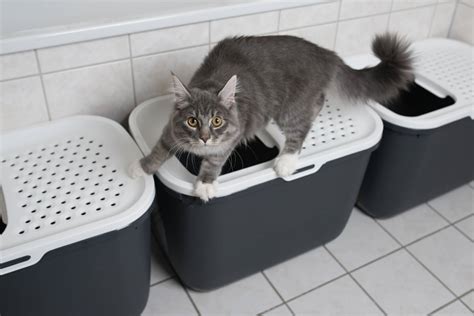Introduction: The Territorial Imperative in Cats
Cats, as territorial animals, instinctively establish and defend their personal spaces, including their litter boxes. Understanding this behavior is crucial to maintaining a harmonious household with multiple feline companions.

Litter Box Number and Placement: Striking a Balance
The number and placement of litter boxes play a significant role in cat territorial behavior. Here’s a practical guide:
Number of Litter Boxes:
- One litter box per cat plus one extra: “N+1” Rule
- Multiple boxes provide escape routes, reducing territorial aggression
Litter Box Placement:
- Separate locations for each box
- Avoid high-traffic areas or near food and water
- Boxes should be large enough for cats to turn around comfortably
Litter Box Hygiene: A Clean Haven
Immaculate litter boxes are essential for preventing territorial disputes.
Scooping Frequency:
- Scoop daily to remove solid waste
- Weekly deep cleaning with a mild disinfectant
Litter Type:
- Choose litter that is soft, absorbent, and odor-controlling
- Avoid frequent litter changes, as cats prefer familiar scents
Territorial Disputes: Causes and Resolutions
Despite proper litter box management, territorial disputes may still arise. Identifying the underlying causes is key to finding solutions.
Causes of Territorial Disputes:
- Insufficient number or poor placement of litter boxes
- Unclean litter boxes
- Stressful or anxiety-inducing factors
- Inter-cat relationships
Resolving Territorial Disputes:
- Address the underlying cause (e.g., add a litter box, improve hygiene)
- Use pheromone diffusers to create a calming environment
- Supervise cat interactions for early detection of aggression
Litter Box Training: Establishing Boundaries
Proper litter box training sets the foundation for harmonious feline relationships.
Training Techniques:
- Start training as early as possible
- Use positive reinforcement (e.g., treats, praise)
- Place the cat in the litter box several times a day
- Gradually move the litter box to the desired location
Case Study: Litter Box Wars in a Multi-Cat Household
A multi-cat household with three cats illustrates the importance of understanding territorial behavior.
Background:
- Three cats in a two-bedroom apartment
- Two litter boxes initially provided
Problem:
- Territorial disputes, resulting in aggressive behavior
Resolution:
- Added a third litter box in an unused corner
- Increased litter scooping frequency
- Implemented pheromone diffusers
Outcome:
- Significant reduction in territorial aggression
- Cats comfortably used all three litter boxes
Future Trends in Litter Box Management
Innovative technologies offer exciting advancements in litter box management.
Automatic Self-Cleaning Litter Boxes:
- Automated scooping and disposal of waste
- Maintain cleaner litter boxes, reducing territorial disputes
Odor-Eliminating Litter Additives:
- Neutralize unpleasant odors, creating a more inviting space for cats
Conclusion: A Territorial Understanding
Understanding cat litter box territorial behavior is essential for fostering harmony among feline roommates. By addressing the number, placement, hygiene, and potential conflicts, you can create a stress-free environment and ensure the well-being of your beloved cats. Remember, a clean, accessible, and non-threatening litter box goes a long way in maintaining feline peace.
Additional Resources:
- American Veterinary Medical Association: https://www.avma.org/resources/pet-owners/petcare/litter-box-training-and-problems
- International Cat Care: https://icatcare.org/advice/toilet-training-your-cat/
- The Humane Society of the United States: https://www.humanesociety.org/resources/litter-box-problems-and-solutions
Tables:
| Number of Cats | Number of Litter Boxes |
|---|---|
| 1 | 2 |
| 2 | 3 |
| 3 | 4 |
| Litter Type | Pros | Cons |
|---|---|---|
| Clay | Absorbent, inexpensive | Dusty, non-biodegradable |
| Crystal | Low-odor, absorbent | Expensive, small crystals can be sharp |
| Silica | Non-allergenic, low-odor | Can be noisy |
| Territorial Behavior Indicator | Cause | Solution |
|---|---|---|
| Refusal to use litter box | Unclean litter box, stress | Scoop daily, increase litter boxes |
| Aggression towards other cats | Insufficient litter boxes, poor placement | Add litter boxes, separate locations |
| Elimination outside litter box | Medical issue, territorial anxiety | Consult a veterinarian, address anxiety |
Tips:
- Consider using different litter types to find what your cats prefer.
- Avoid punishing your cat for litter box issues, as this can worsen the problem.
- Patience and consistency are key to successful litter box training.
- Monitor your cats’ litter box habits regularly to detect any changes that may indicate territorial disputes or health problems.
- If you encounter persistent territorial aggression, consult with a veterinarian or animal behaviorist for professional guidance.





















